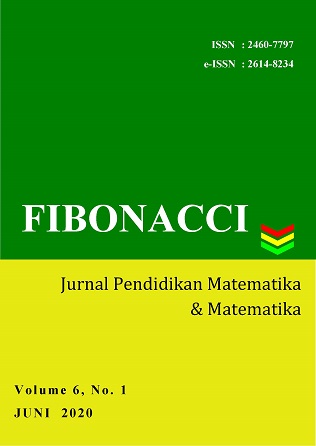MENINGKATKAN KEMAMPUAN BERPIKIR KRITIS MATEMATIS PESERTA DIDIK DENGAN LEMBAR KERJA PESERTA DIDIK BERBASIS TEORI VAN HIELE
DOI:
https://doi.org/10.24853/fbc.6.1.59-66Kata Kunci:
Kemampuan Berpikir Kritis Matematis, Teori Van Hiele, GeometriAbstrak
Kemampuan berpikir kritis merupakan kemampuan yang diperlukan dalam perkembangan dunia saat ini. Namun, kemampuan berpikir kritis peserta didik masih rendah. Halminimdisebabkan peserta didik masih ketergantungan kepada guru dalam menerima informasi serta pembelajaran yang terjadi di kelas belum memfasilitasi kemampuan berpikir kritisnya dalam bidang geometri. Untuk itu dikembangkan lembar kerja peserta didik berbasis teori Van Hiele yang diharapkan dapat membantu mengatasi masalah tersebut. Tujuan dari pengembangan produk ini yaitu untuk mmenghasilkan mlembar kerja peserta didik berbasis teori Van Hiele yang efektif dalam meningkatkan kemampuan berpikir kritis matematis peserta didik kelas VIII SMPN 13 Padang. Subjek penelitian ini adalah peserta didik kelas VIII SMPN 13 Padang. Model pengembangan yang digunakan diadaptasi dari model Plomp. Ada tiga tahapan pada model ini yaitu preliminary research, prototype phase, and assesment. Pada penelitian ini difokuskan melihat keefektifan produk pada tahap assesment. Tahap assesment dilakukan pada uji lapangan (field test) yang terdiri dari 30 peserta didik selama 6 kali pertemuan. Keefektivan produk dilihat setiap pertemuan pada tahap field test serta tes yang diberikan pada akhir pertemuan. Hasil penelitian diperoleh bahwa kemampuan berpikir kritis matematis peserta didik cenderung meningkat selama enam kali pertemuan serta tes akhir juga menunjukkan bahwa terjadinya peningkatan sebesar 73,33%.Referensi
Abdussakir, A., Islam, U., Maulana, N., & Ibrahim, M. 2018. Pembelajaran geometri sesuai teori van hiele. (June). https://doi.org/10.18860/jt.v2i1.1832
Fauzan, A. 2013. Pengaruh Pendekatan RME dan Kemandirian Belajar Terhadap Kemamampuan Matematis Siswa. 7–14.
Fitriyani, H., Widodo, S. A., & Hendroanto, A. 2018. Students ’ Geometric Thinking Based On Van Hiele ’ S Theory. 7(1), 55–60. https://doi.org/10.22460/infinity.v7i1.p55-60
Hiele-geldof, D. Van, & Hiele, P. M. Van. 1987. The van Hiele Model of the Development of Geometric Thought. 1–16.
Kusumah, Y. S., Sabandar, J., & Herman, T. 2015. Mathematical Critical Thinking Ability Through. Mathematical Critical Thinking Ability Through Contextual Teaching And Learning Approach, 6(1), 53–62.
Nasution, D. H., & Yerizon. 2019. Development of student worksheets based on discovery learning to improve student mathematical problem solving ability in class X senior high school. International Journal of Scientific and Technology Research, 8(6).
Omar, Z. 2013. The Effects of Van Hiele’s Phases of Learning Geometry on Students’ Degree of Acquisition of Van Hiele Levels. Procedia - Social and Behavioral Sciences, 102(Ifee 2012), 251–266. https://doi.org/10.1016/j.sbspro.2013.10.740
Peter, E. E. 2012. Critical thinking : Essence for teaching mathematics and mathematics problem solving skills. Critical Thinking: Essence for Teaching Mathematics and Mathematics Problem Solving Skills, 5(3), 39–43. https://doi.org/10.5897/AJMCSR11.161
Primary, I., Plomp, T., & Illustrative, P. B. 2019. The development of an RME-based geometrycourse for Indonesian Primary schools The Development of an RME-based Geometry Course for Indonesian Primary Schools. (2013).
Primasatya, N. 2018. Implementation of Geometry Multimedia Based on Van Hiele ’ s Thinking Theory for Enhancing Critical Thinking Ability for Grade V Students. 1(2), 56–59. https://doi.org/10.33122/ijtmer.v1i2.40
Ramlah, H., & Jantan, B. 2014. Relationship b etween Students ’ Co gnitive Style (Field- Dependent and Field – Independent Cognitive Styles) with their Mathematic Achievement in Primary School. 1(10), 88–93.
Razak, F., Sutrisno, A. B., Muchsin, S. B., & Rosida, V. 2018. Using the Van Hiele theory to analyze primary school teachers ’ written work on geometrical proof problems Using the Van Hiele theory to analyze primary school teachers ’ written work on geometrical proof problems. Using the Van Hiele Theory to Analyze Primary School Teachers’ Written Work on Geometrical Proof Problems, 1013(2018).
Surya, E. 2017. LEARNING BASED ON THE CONTEXT OF ACEH CULTURAL TO IMPROVE DEVELOPMENT OF LEARNING DEVICE BASED CONTEXTUAL TEACHING AND LEARNING BASED ON THE CONTEXT OF ACEH CULTURAL TO IMPROVE MATHEMATICAL REPRESENTATION. (February).
Vojkuvkova, I. 2012. The van Hiele Model of Geometric Thinking Van Hiele theory. 72–75.
Wati, S. K., & Musdi, E. 2018. Effectiveness of Developing Mathematical Learning Device Based On Open Ended Approach To Improve Mathematical Creative Thinking Ability Of Junior High School Students. 285(Icm2e), 242–245.
Yerizon, Y., Putra, A. A., & Subhan, M. 2018. Mathematics Learning Instructional Development based on Discovery Learning for Students with Intrapersonal and Interpersonal Intelligence (Preliminary Research Stage). International Electronic Journal of Mathematics Education, 13(3), 97–101. https://doi.org/10.12973/iejme/2701
##submission.downloads##
Diterbitkan
Terbitan
Bagian
Lisensi
Authors who publish with this journal agree to the following terms:
- Authors retain copyright and grant the journal right of first publication with the work simultaneously licensed under a Creative Commons Attribution License that allows others to share the work with an acknowledgement of the work's authorship and initial publication in this journal.
- Authors are able to enter into separate, additional contractual arrangements for the non-exclusive distribution of the journal's published version of the work (e.g., post it to an institutional repository or publish it in a book), with an acknowledgement of its initial publication in this journal.
- Authors are permitted and encouraged to post their work online (e.g., in institutional repositories or on their website) prior to and during the submission process, as it can lead to productive exchanges, as well as earlier and greater citation of published work (See The Effect of Open Access).


